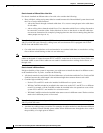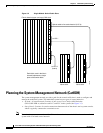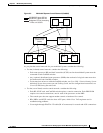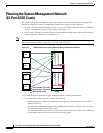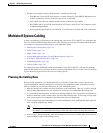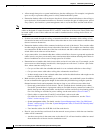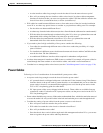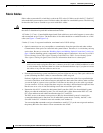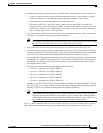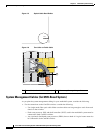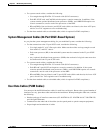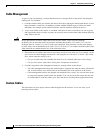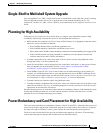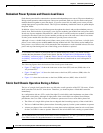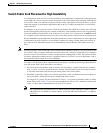
3-16
Cisco CRS-1 Carrier Routing System 16-Slot Multishelf System Site Planning Guide
OL-7422-04
Chapter 3 Multishelf System Planning
Multishelf System Cabling
Fabric Cables
Fabric cables connect the S2 switch fabric cards in the FCC to the S13 fabric cards in the LCC. Each LCC
in the multishelf system requires a set of 24 fabric cables (48 cables for a multishelf system). The following
list describes the issues to consider as you work with fabric cables:
Caution Do not put pressure on fabric cables, which can damage the cables over time. In addition, do not twist
the cables or bend them beyond their minimum bend radius:
1.25 inches (3.17 cm)—Controlled 90-degree bend. Each cable has a strain-relief support (or turn collar)
with an attached strip of Velcro. The bend radius of the cable should be no smaller than the arc of this
collar (see Figure 3-5 and Figure 3-6).
2 inches (5.1 cm)—Long term installation, maximum load of 150 lb (68 kg).
• Optical connections are very susceptible to contamination from dust particles and other residue.
Contamination of the optics can cause link and system failures. Therefore, it is critical that you keep
optics clean. Be sure to review the “Handling Optics and Making Optical Connections” section on
page 4-6 before handling optical components or making optical connections. Also see Cisco CRS-1
Carrier Routing System Fiber-Optic Cleaning Guide and Cisco CRS-1 Carrier Routing System
Fiber-Optic Cleaning Kit Quick Start Guide for information about how to clean optics.
Note Fabric cables have metal dust caps that cover both ends of the cable. Do not remove the dust caps
until you are ready to plug the cable into a connector on an S13 card or OIM. In addition, be sure
to save the dust caps and store them in a clean area. Reattach the dust caps if you plan to reroute
the cables or any time the cables are not in use.
• Plan enough time during system installation to perform a light test on every fiber-optic cable in the
system (including the fabric cables) to ensure that the cables are good.
Perform a light test on every fiber-optic cable before you connect the cable. Pass a pen flashlight
over each of the fibers in the cable connector and check the other end of the cable to make sure that
you see the light as it passes over each fiber. If all fibers in the cable glow, the cable is good and
you can connect it. If even a single fiber does not glow, the cable is bad and must be replaced. Note
that this test saves a lot of time and cabling rework due to bad fiber-optic cables.
• Determine which LCC contains the designated shelf controller (DSC) for the multishelf system.
When you cable the multishelf system, you will install fabric cables between the DSC LCC and
FCCs first and then install cables between the other LCC and FCCs.
The DSC serves as the master route processor (RP) for the multishelf system. It controls the
systemwide administrative functions for all multishelf system chassis. Initially, the DSC is the
active RP in the LCC with the lowest rack number (rack number 0).
You can use the dsc command to assign rack numbers to each LCC. If you do not assign rack numbers,
the primary RP in the first chassis to boot assumes the role of DSC.



